|
'I wouldn't give you two
cents for a dame without a temper.' (High Sierra)
Film Noir entries are often
described as stylized crime dramas or murder thrillers that
emphasize moral ambiguity - enticing 'basically' good citizens to
commit illegal acts (of varying degrees) for money... or more
frequently for amorous desire and/or unrequited love. However,
although there is no commonly accepted definition - it would be hard
to deny that sexual tension and its corresponding desperate
motivations make up a big part of the appeal of the
Film Noir phenomenon. The
universality of this human condition is but one explanation of how
films that cascade into the noir cycle are continuing popularity
some 60+ years later. Along with narrative devices such as anti-hero
protagonists, plots utilizing amnesia, recent ex-convict characters,
flash-backs (remembered), shared guilt, pathos etc. - femme fatales
(and women characters who were often incorrectly labeled as such
either with or without selfish motivations), have become strongly
associated with the 'black cinema'. Delving adventurously into
classic
Film Noir it would seem
impossible not to gravitate to certain performers - identifying them
as 'favorites'. They can help qualify any personal definition to a
higher, if bastardized, ideal. I've named only fourteen ladies in
the shadows below but the list could have certainly expanded to
more.
Further, upon investigation, I find it a dramatically unsettling
coincidence that the majority of actresses
I've chosen to showcase in this article have shared
tragic circumstances in their personal lives. These range
from premature deaths, battles with alcohol, fatal burns (house
fire), depression, alleged mental illness and even a suicide...
coincidental and sad but nevertheless it seems to punctuate the
mystique surrounding the doomed romantic aura existing in much of
Film Noir - their personal
tragedies adding yet another venomous layer to the style's dark
legacy.
(NOTE: CLICK ON
IMAGES FOR OVERSIZED VERSIONS, OR UNDERLINED TEXT FOR HYPERLINKS)
'
|
 |
|
The Innocent' -
Cathy O'Donnell
With her early role of wholesome and loyal Wilma in the
1946 classic
The Best Years of Our Lives (1946),
Alabama born and raised Cathy O'Donnell
will always be
reminded by legions of fans as the girl next door.
It is quite probable her role in that film helped coined
the phrase.
Best Years
success boded well for Cathy and
soon she co-starred in the now-iconic
Film Noir
classic
They Live by
Night (1948). Farley Granger
and Cathy were paired yet again in a
Noir
effort; Anthony Mann's
Sidestreet two
years later.
It all
started with a
gamble when
Ann Steely
(birth name) moved out to Hollywood at a very young age
where her talent, beauty and charm were easily
identified. Fortune landed
her a contract under Sam Goldwyn.
Extensive vocal training (to remove her
thick Southern drawl)
and acting lessons seemed to be pushing Cathy into
a future with a long and successful career. |
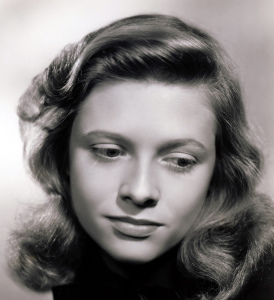 |
|
However, her rise on the silver screen was sidetracked when, at age 23,
she married Robert Wyler (more than double her age) - the older brother of director
William Wyler, with whom Mr. Goldwyn was engaged in a bitter feud. In retaliation Goldwyn
abruptly canceled her contract. Unfortunately thereafter she had no lasting
bond with any studio. Her most memorable roles of
the were in classic
Film Noir's
such as
They Live by Night (1948)
Detective Story
(1951),
Sidestreet
(1950) and
Bury Me Dead (1947). In
fact, of Cathy's 17 films (of which she had starring or featured
roles), 7 are
Film Noir
(or debatable-Film
Noir).
This makes her a major, although often underrated, contributor to the
style. Her last film was
Ben-Hur
(1959). Her marriage to Wyler proved long-lasting but was
unsuccessful in their attempts to have children. Her premature death on
their 22nd wedding anniversary, at only 45 years of age, followed an
extensive struggle with cancer. |
|
 |
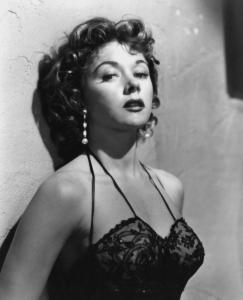 |
'The Siren' -
Gloria Grahame
In her
first role - that of Sally Murfin in Blonde Fever
(1944) - Gloria's character states: 'Mr.Donay there
are two kinds of girls - good girls and the other kind.
I hope you don't think I'm the other kind.'
Regardless, a few years later her role as
distracting Violet in
It's a Wonderful Life
pushed to define her persona as a sexy temptress ripe
for supporting and feature roles in the adult oriented
crime dramas of the day.
After appearances in such films as
Song of the Thin Man,
Gloria found a premium vehicle for exposure as Ginny Tremaine
in RKO's
Crossfire -
directed by Edward Dmytryk in 1947. Although not a
starring role it would prove to be the film capable of
escalating her to stardom and eventually far more
defining performances. Her excellent work in
Crossfire was
gratifyingly nominated for an
Academy Award (eventually losing to Celeste Holm in
Gentleman's Agreement). |
|
Gloria received further critical
recognition in 1952 for both
Macao and
Sudden Fear. Although she proved very
talented in musicals like
Oklahoma! (1955) Gloria's intrinsic
sexuality and seductive visage will be forever associated with
Film Noir
primarily due to her classics roles in such notable entries as
In a Lonely Place (1950),
The Big Heat (1953)
Naked Alibi (1954) and
Human Desire (1954).
She continued some memorable
television work later in her career (see Episode 28: The Homecoming of Season One of
The Fugitive with David Janssen). Gossip surrounded her private life as she underwent frequent and
unnecessary plastic
surgeries and Gloria's fourth marriage produced further scandalous headlines as
she married her former stepson, producer/director Anthony Ray (director Nicholas
Ray's son). She bore him two children in the early 1960s but on October 5, 1981, at
the age of 57, she succumbed to cancer leaving a legacy of cinema that is
unforgettable to her fans. Some trivia about her background includes support
that Gloria was descended from royalty. Her father's family descended from King
Edward III through John of Gaunt; her mother's, from the Scottish Kings of the
Hebrides and Gloria's grandfather Reginald Francis Hallward was said to have
given Oscar Wilde the idea for his classic novel 'The
Picture of Dorian Gray.' Although enigmatic Gloria is mentioned in many
Noir and Hollywood books I only ever found one entirely devoted to her;
Suicide Blonde: The Life of Gloria Grahame
by Vincent Curcio.
NOTE: Gloria's fans may wish to check out the 2017 movie
"Film
Stars Don't Die in Liverpool", based on
Peter
Turner’s memoir about Gloria Grahame's last days of her life in
Liverpool, where the author and his family cajoled, comforted, and wept with the
dying Hollywood star.
We have a Photo Archive of Gloria
HERE (check it out!)
|
|
 |
|
'The Beauty' -
Carole Landis
Carol Landis
(Frances Ridste) was an uncommon beauty and desirable
war-time pin-up star. After graduating high school in
1935, and scurrying away from an impetuous marriage, she
fled to San
Francisco to work as a nightclub dancer and band singer. She
eventually got to Hollywood
at age 18 where it took only a few years to identify her
in motion pictures as the skin-clad lead in One Million B.C. (1940)
with Victor Mature. Her only notable
Film Noir,
I Wake Up Screaming
(1941) was well received as was her individual
performance. Despite fabulous potential in comedy,
musicals and some quasi-noir 'B' films - Twentieth Century
Fox dropped her contract due to her volatile feminist
stances and sexual dalliance rumors essentially stemming from an
inability to build any lasting relationship. After
visiting troops during World War II Carol contracted
malaria, amoebic dysentery, and
near-fatal pneumonia. |
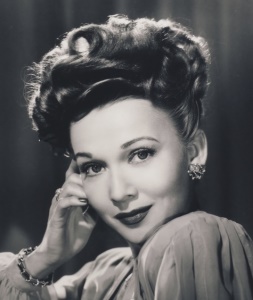 |
|
With
financial problems, a halted career, declining health,
four failed marriages behind her, and a disappointing
culmination of her extra-marital affair with
Rex Harrison, Carole Landis committed suicide with an
overdose of Seconal in 1948. She was only 29 years old
but had appeared in more than 60 films - her potential
barely touched upon. For further information see E. J.
Fleming's book -
Carole Landis: A Tragic Life In
Hollywood.
|
|
 |
|
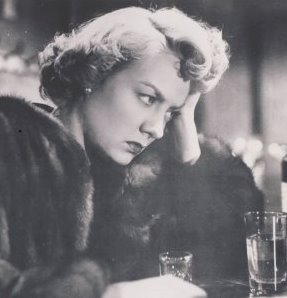
|
'The Bad Girl' -
Audrey Totter
Audrey
Totter, born of Austrian/Swedish heritage, might be the
most prolific
Noir actress on this list. Her balance of
aggressive 'hard' looks and alluring feminine beauty found a
perfect niche in shadowy confines of 'B'
Film Noir.
Sometimes cast as the tired and vexed wife (The
Set-Up), the easy-pick up (The
Postman Always Rings Twice) or the
selfish gold-digging tramp (Tension
and The Unsuspected) Audrey defined her roles
with totally believable characterizations in the mature
world of dark realism that
Noir tends to export.
.
Audrey's
fatal blow, as to many in her profession, was to be
stereotyped because of her efficient performances. As
the tide of cinema turned to more family oriented films
she found positions for her edgy 'tough-talking dame'
roles began to dry-up. So be it. She wed a doctor and
focused her energies on raising a family but her
performances
supporting
Film Noir
will always be remembered as essential to its legacy.
|
|
 |
|
'The Heights and Depths' -
Veronica Lake
One can
read the life story of 4'11" Veronica Lake (born
Constance Frances Marie Ockelman) in sheer disbelief -
certainly more dramatic than any of the roles she
portrayed. Born in Brooklyn, New York on November 14,
1919 Veronica would escalate to legendary status in the
Film Noir movement. During an early publicity
photo, an errant lock of her shoulder-length blonde
hair, covering half her face, led to an iconic
peekaboo hairstyle that remained widely imitated by
women for years after. Her contribution to the
Film Noir cycle in
the 1940's included some of the quintessential efforts
of the style. She starred with Alan Ladd in the 3
mainstays;
This Gun for Hire
(1942),
The Glass Key
(1942) and
The Blue Dahlia
(1946). Unfortunately the latter being recognized as her
last lauded film work.
|
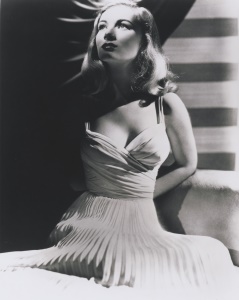 |
|
Adored
by the public but those who worked with her had a
different story to tell. Her frequently reported
combative fiduciary relationships stemmed from her
complex personality possibly resulting from an allegedly
undiagnosed paranoid schizophrenia. Alcohol abuse and
crumbling marriages (one with director André De Toth)
soon followed and the Peek-a-boo Girl,
distanced from friends and three children, arrested
several times for public drunkenness and disorderly
conduct, and bankrupt because of IRS seizure of assets
due to unpaid taxes - was totally removed from the
public eye. She eventually emerged working as a barmaid
at the all women's Martha Washington Hotel in Manhattan
and by the late 1960s, Veronica Lake, residing in
Hollywood, Florida, was reportedly immobilized by
paranoiac fear with claims that she was being stalked by
the FBI.
On
July 7, 1973, Veronica died of hepatitis and acute renal
failure (due to alcoholism) near Burlington in
Vermont. The beautifully fragile actress, of Danish and
Irish descent, once adored by millions,
was dead at the age of 53. A frank depiction and
timeline of Lake's flawed life is catalogued in
Peekaboo: The Story of Veronica
Lake by Jeff Lenburg.
|

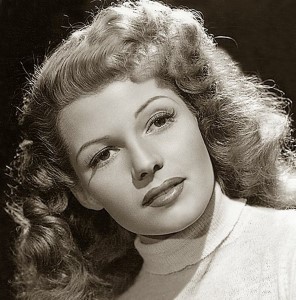 |
'The Goddess' -
Rita Hayworth
Rita Hayworth (born Margarita Carmen Cansino) may have
had one of the most seductive relationships
with the camera in Hollywood history. She exuded an
undeniable hypnotic aura supporting her moniker "The
Love Goddess" and further identifying her as the
major sex
symbol of the 1940's.
Naturally shy and
reclusive, Hayworth was the antithesis of many of the
characters she played. She once commented that "Men
go to bed with
Gilda, but they wake up with me".
This statement embodied her paradoxical existence as she spent her
life subjected to other people's perceived definition of
her. Her
personal relationships were often strained due to both
this and alleged physical, sexual and emotional abuse she
endured from her father at a very young age. |
|
Gifted as a
multi-faced performer who could sing, dance and star in
comedies, Rita Hayworth's limited contributions to the
Noir cycle included, future husband, Orson Welles' complex
The Lady from Shanghai
made in 1947, and two films co-starring her long-time
next door neighbor and good friend Glenn Ford -
Charles
Vidor's
Gilda made in 1946
and Vincent Sherman's
Affair in Trinidad
from 1952, where the world saw her return from her 1948
marriage to Prince Aly Khan, the heir to Aga Khan III.
Like many
Noir gals here her personal life was often
discontented.
With a string of five failed marriages behind her and an
ongoing battle with alcohol, Rita Hayworth passed away
from Alzheimer's disease in 1987 at age 68. Many modern film
audiences were exposed to Rita from a clip and poster
from
Gilda used in the
1994 film
The Shawshank Redemption.
There are numerous books about Rita Hayworth but I
thought
Being Rita Hayworth: Labor,
Identity, and Hollywood Stardom by
Adrienne L. McLean did a good job of capturing the
essence of what was the highly misunderstood lady; Margarita
Carmen Cansino.
|

|
|
The Queen of 'B' -
Marie Windsor
Born in
Marysvale, Utah, Marie Windsor schooled at Brigham
Young University and went on to establish a long career
appearing in over 100 films. Her efforts in
Film Noir
often found her pigeon-holed as an adulterous wife, loose
girlfriend, or gangster moll. She worked with actors John
Garfield and Elisha Cook Jr. but her reputation in minor B's
is also apparent with infamous roles in Swamp Women
(1955), Cat-Women of the Moon (1953) and
The Jungle (1952).
Favorites of her
work include the brutal, poetic and pessimistic
Force of Evil (1948),
the redemptive western Hellfire (1949) - currently
unavailable on DVD!, the highly touted 'B' masterpiece
The Narrow Margin
(1952),
No Man's Woman, and Stanley Kubrick's tense Noir thriller
The Killing (1956).
|
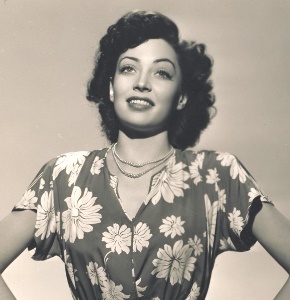 |

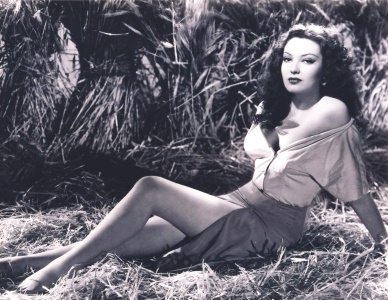 |
'The Heroine' -
Linda Darnell
Exotic
looking, native Texan, Monetta Eloyse Darnell gave some
significant performances to benefit her inclusion in the
list although her most critically acclaimed roles were
not in
Film Noir.
After the sterling John Ford western
My Darling Clementine
(1946) and her more lauded work in Preston Sturges
comedy
Unfaithfully Yours
(1948) - Linda followed those with a fine performance,
but again Oscar neglected, as one of the spouses in
A Letter to Three Wives.
Her sultry characters in
Hangover Square
(1945) and strong Noirs like
Fallen Angel
(1945), and
No Way Out (1950)
were likewise unjustly passed over causing her to drift
into alcohol, resulting in failed marriages and seeing her gain
significant weight. |
|
Expectantly important starring roles became fewer and
farther between.
One of her most transparent performances was
Zero Hour! (1957),
near the end of her career, teaming her with past
co-star Dana Andrews. Indifferent panning helped push
her back into live stage productions. Sadly though she
died a horribly painful death at age 41. She heroically
attempted to save her friend's child from a house fire
in Glenview, Illinois unaware that the young girl was
already safe. Linda Darnell was badly burned over 80
percent of her body and she died the following day.
Ronald L. Davis has a book;
Hollywood Beauty: Linda Darnell
and the American Dream that I recommend
if you are keen on more about her short life and career.
|

|
'The Canuck' -
Yvonne De Carlo
Talented
Yvonne De Carlo was born Margaret (Peggy) Yvonne
Middleton on September 1st, 1922, in Vancouver, British
Columbia, Canada. Her contribution to
Film Noir may be
limited - a small role in
This Gun for Hire
(a showgirl at Neptune Club) but two iconic films; -
both with Burt Lancaster - Jules Dassin's impacting
prison picture
Brute Force (1947)
and Robert Siodmak's brilliantly cynical
Criss Cross (1949)
mark her with significant firepower to deserve mention.
Hired by Paramount primarily because of a resemblance to
Dorothy Lamour she later moved to Universal Studios, as
a kind of B-movie western version of Maria Montez (The
Caribbean Cyclone) who, by the way, was far less
talented in all areas - singing, dancing and acting.
When Maria left Hollywood for Europe Yvonne's career
began to pick up steam. |
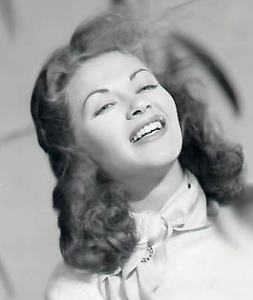 |
|
Although
her most prominent film role would be as Sephora,
the wife of Moses (Charlton Heston) in
The Ten Commandments
(1956) unfortunately pop culture has slapped Yvonne with
television's Lily Munster as her most widely remembered
character. The bizarre cult television series The
Munsters ran from 1964-1966. Yvonne De Carlo penned a revealing
autobiography in 1987 entitled
Yvonne: An Autobiography
and she passed away January 2007 at
the age of 84 from natural causes.
|

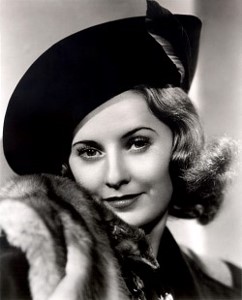 |
'The
Queen' -
Barbara Stanwyck
An icon
of film and
Noir
while faithfully playing resilient and confident
female characters that almost always had a likeable edge -
Barbara Stanwyck was born Ruby Catherine Stevens on
July 16th, 1907 in New York City to a Canadian
immigrant mother from Nova Scotia. Starring in
almost one hundred films during her career she
received four nominations for Best Actress Oscars
for roles in
Stella Dallas
(1937),
Ball of Fire
(1941), Sorry, Wrong Number (1948) and Billy
Wilder's sleazy adulterous
Noir
thriller
Double Indemnity
(1944). Stanwyck is on more frames of celluloid than
any performer on this list and seemed to add a
certain class to every production in which she was
engaged. This included extensive work in television
were her performances as the proud matriarch in the
western series
The Big Valley
(1965–1969) made her one of the most popular
actresses on TV, winning her a second Emmy. |
|
Notable
classic
Noirs
include
The Strange Love of Martha
Ivers (1946),
The Two Mrs.
Carrolls (1947),
The File on Thelma Jordon
(1950), No Man of Her Own (1950), the
afore mentioned
Double Indemnity
(1944) and Sorry, Wrong Number (1948). For a
more in-depth analysis of her life seek out the book
Starring
Miss Barbara Stanwyck from RH Value
Publishing.
|

|
'The
Divine' -
Gene Tierney
Another New York born lady... Gene Eliza Tierney of
Brooklyn was often regarded as the most
beautiful woman of the 20th century. She is
best-remembered for her performance in the
Noir,
or
Noir
leaning, films;
The Shanghai Gesture
(1941),
Laura
(1944),
Leave Her to Heaven
(1945),
Whirlpool
(1949),
Night and the City
(1950),
Where the Sidewalk Ends
(1950) and
Black Widow (1954). These
Noir
works produced some of her most memorable
performances.
Early
in her career Tierney was offered the lead in
MGM's National Velvet (Elizabeth Taylor),
but when the production was severely delayed,
she instead signed with 20th Century Fox in
1939. Her silver screen debut was as Elenore
Stone in Fritz Lang's first color film, the
western
The Return of Frank James
(1940) opposite Henry Fonda. |
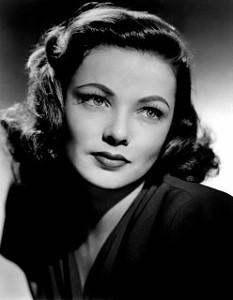 |
|
Gene
was not free of the
Noir
curse of personally destructive circumstances as
she battled severe depression which included
treatment by hospitalization and shock therapy.
This could have been a result of Daria, her
prematurely born daughter (with husband, fashion
designer, Oleg Cassini), who entered the world
deaf, partially blind and had severe mental
retardation. Potentially this may also have
accentuated Gene's diagnosed bi-polar disorder.
She is reported to have had affairs with Prince Aly Khan, co-star Tyrone Power and future
president John F. Kennedy (causing her to
admittedly vote
for Nixon). Fans may wish to obtain
Gene Tierney: A Biography
by Michelle Vogel for a view on her complete
life story. |
|

 |
'The
Icy' -
Lizabeth Scott
Emma
Matzo was born in 1922 to Catholic-Slovakian
parents. She studied drama in New York City and
appeared in just over 20 films between 1945 and 1957
- many of which became central to the legacy of
film noir including
The Strange Love of Martha
Ivers (1946),
Desert Fury
(1947),
Pitfall (1948),
I Walk Alone
(1948),
Too Late for Tears (1949),
Dead Reckoning
(1947), Dark City (1950) and
Stolen Face
(1952). Adopting the stage name Lizabeth Scott
(which she legally changed it to in 1949 after four
years of using it professionally) the former
part-time model and Broadway understudy (at times
for the great Tallulah Bankhead!) had an indefinable
quality that the camera, and fans, found intriguing,
seductive while an the same time congenial. Blonde,
bright-eyed, and raspy-voiced Lizabeth was one of a
handful of women who's grass-roots performances were
often responsible for imbedding film noir
characters with the qualities of trust,
respectability and honor while frequently supporting
a wayward protagonist. These characteristics often
juxtapose the inherent selfishness and greed of many
femme fatale personas. |
|
According
to Diana McClellan's book "The
Girls," Lizabeth Scott (who never
married) was essentially black-listed late in her
career for her perceived sexual orientation. She was
supposedly seen in Los Angeles lesbian night clubs
and associated with like-minded women as
reported in the gossip columns. Since her brief
return to the screen in
Pulp (1972 with
Michael Caine) Lizabeth Scott retreated from public
view and has declined all interview requests. She
will have recently turned 85 years of age at the
writing of this article.
|
|

|
'The
Dangerous' -
Faith Domergue
For most of her life Faith Domergue, (pronounced
"Dah-mure"), had always thought she was of
Spanish / French descent as are many people in
her birthplace of New Orleans, Louisiana.
However, much later in her life she found out
that she was adopted and of English / Irish
heritage - 'Black Irish' as it's known; people
with dark brown or black hair of Irish descent.
Regardless, Faith still had a remarkable 'look'
on celluloid with penetrating, hypnotic, dark
eyes that are still mesmerizing male viewers
some 50 years later. A gifted child who spoke
fluent French, Spanish and Italian, Faith was
spotted at only 15 years of age by
industrialist-producer-director-aviator Howard
Hughes who signed her to his RKO studio as one
of his many desirable protégées. But Hughes made
her complete her high school education with a
private tutor before launching her career as an
actress. |
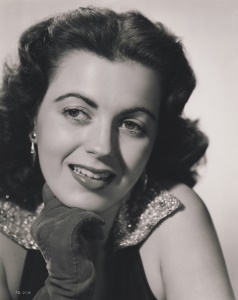 |
|
Unfortunately the painfully long production of
one of her very first films, Vendetta
(1950), soured her on acting as a profession
eventually impacting quite negatively on her the
rest of her life.
For Film Noir fans her role as the warped
and manipulative femme fatale Margo Lannington
in John Farrow's classic, bustling, and
dream-like
Where Danger Lives
(1950), with stalwart co-star Robert Mitchum, is
ultimately a defining one. In an unforgettable
scene, late in the story, we see the imminent
confrontation of our protagonists - a doctor and
a patient... on the run from the law. It was
shot in one long take within the confines of the
small, unlit hotel room where Margo and Jeff are
seeking refuge before sneaking into Mexico.
Farrow defines the film's climax within this
limited space and the once-lovers impending
desperate acts are soon to follow. As the
characters, and camera, venture outside we are
engulfed in shadows and the suspense of the
conflict becomes overwhelming - reaching an
unforgettable finale.
Faith's career saw her perform in some science
fiction films including the iconic, cult classic
This Island Earth
from 1955. She passed away at 75 years of
age in her Santa Barbara, California home in
1999. |

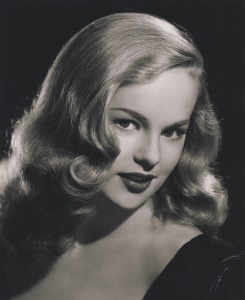 |
'The
Spirited' -
Peggy Cummins
Peggy
Cummins was born in Prestatyn, Wales in 1925 and
with a visage encapsulating both wholesome
and stunning qualities she might have been
the quintessential poster girl representing 'the
farmer's daughter'. She had defining roles in two
important movies that have acquired a strong
journalistic following. She played Joanna Harrington
in Jacques Tourneur's poetic and suspenseful
Night of the Demon
(1957) with Dana Andrews. But the most important
cinema work of Peggy's career might easily be Joseph
H. Lewis'
Gun Crazy from
1950 (also know as Deadly Is the Female). It
is often considered one of the greatest 'B' movies
ever made and an essential film noir. It was
a 'Bonnie and Clyde'-like drama involving two
desperado fugitives who emotionally spark desirous
larger-than-life exploits in each other... with
fatal consequences. Peggy also supported Noir
in the UK with a lauded quasi-'dark cinema'
effort entitled
Hell Drivers
(1957) where she co-starred with Stanley Baker,
Patrick McGoohan, Herbert Lom, Sid James, Jill
Ireland, David McCallum and Sean Connery.
|
|
Her
parallels with Faith Domergue (above) are not only
that she appeared in one immensely important film
noir work but she was also romantically involved
with Howard Hughes at one point. Approaching her
82nd birthday later this year (2007) individuals
still comment on her elegance and beauty although
legions of fans will always remember her as 'sharp-shooting
sideshow performer Annie Laurie Starr'.
|

|
'The
Indiscreet' -
Joan Bennett
Joan Bennett
represented true classic femme fatale characters
- cynical, greedy, untrustworthy, but always
sexy; a gal with an innocent look that every sap
would want to protect - usual at a high cost.
Joan Geraldine Bennett was born in Palisades,
New Jersey on February 27th, 1910. Both parents
were successful stage actors and her
father, Richard Bennett, was championed by Orson
Welles, who cast him in
The Magnificent Ambersons.
Her older sister Constance grazed the Noir cycle
herself in
The Unsuspected.
Joan, however, gave some of the more memorable
and impressive performances in dark cinema gems
The Woman In The Window,
Scarlet Street,
The Woman On The Beach,
Secret Beyond The Door…,
Hollow Triumph,
The Reckless Moment,
and
Highway Dragnet.
Her private life was a drama in the making
having been married and already divorced by the
age of eighteen! With child in-tow she embraced
the family's profession |
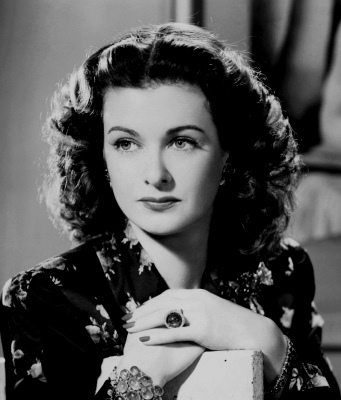 |
|
exuding the abilities like a natural. Her third
marriage was to producer Walter Wanger, who,
suspicious of his younger wife had her followed
by a private detective. The mother of his two
children was, indeed, having an affair... with
her agent, Jennings Lang. Wanger, producer of a
few of his wife's Noir efforts as well as
many other notable films including
Foreign Correspondent
(1940),
Smash-Up: The Story of a
Woman (1947), and
Riot in Cell Block 11
(1954), found out details of the indiscretions
taking place in a Beverly Hills apartment
love-nest. In 1951, after catching them 'in
the act' in Bennett’s car, he shot Lang in
the testicles with a .38 pistol. Wanger pleaded
insanity and was convicted of attempted murder
and served a four-month sentence. Always a
popular target of Hedda Hopper's gossip
column, this incident finished her career from
any further notable studio roles.
Her 78 feature-length films include three bit
parts in silents and 6 TV-movies. She made five
films for Fritz Lang, more than any other
American actor or actress who he had worked
with. Joan died of a heart attack in Scarsdale,
New York in 1990. She was 80 years old. Joan
Bennett's smoldering temptress portrayals will
always identify her as one of the leading
film-noir femme fatales. |

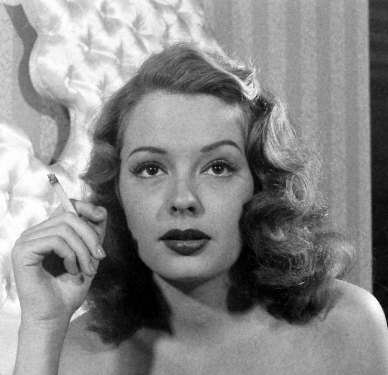 |
'The
Model' -
Jane Greer
Bettejane
Greer was born on September 9th 1924, in Washington
DC and makes our list on the strength of two potent
film noirs - both with Robert Mitchum. She had
modeled and sang professionally from a very early
age and was on the cover of "Life" magazine modeling
army uniforms for women in the 40s. Like two other
gals on the list she caught the eye of
multi-millionaire producer Howard Hughes who signed
her to a contract which jump-started her public
exposure in movies. She would later state that "Howard
Hughes was obsessed with me. But at first it seemed
as if he were offering me a superb career
opportunity."
Her
initiation into the dark cinema may have been
considered to be her role in
The Falcon's Alibi
(1946) co-starring Elisha Cook Jr.. But it was |
|
her performance as sultry femme fatale
Kathie Moffat in 1947's
Out of the Past
(released in the United Kingdom as Build
My Gallows High) directed by Jacques
Tourneur, starring Robert Mitchum and Kirk
Douglas that established her noble, and
unforgettable, positioning in the cycle. The
film was adapted by Daniel Mainwaring with
uncredited revisions by Frank Fenton and
James M. Cain, from his novel and remade in
1984 as
Against All Odds
with Jeff Bridges, James Woods, Rachel Ward
and Greer as a bit part playing her mother.
The film was directed by Taylor Hackford.
The Big Steal
(1949) re-teams Mitchum and Greer as they
transverse Mexican roadways in pursuit of a
grifter with a suitcase of $150,000 in
untraceable bills. This film, sprinkled with
humor and twists, was directed by Don Siegel
and carries some well-crafted tension with
the chemistry of the protagonists still
wholly apparent.
Greer did some notable television work
including appearances on
Alfred Hitchcock
Presents, an episode of
Columbo
entitled
Troubled Waters
and in
Twin Peaks
in 1990, among other roles. She died of
Cancer at age 76 but will live on in Noir
aficionados memories as Kathie Moffat for
her hypnotic "patented look" and "calm,
quizzical gaze" she attributes to remarkably
suffering from a facial palsy which
recovered from at age 15. |

|
'The
Look' -
Lauren Bacall
Betty Joan Perske
was born on September 16th, 1924, in New York
City. Once out of school, 'Lauren' began her
career as a model, and because of her remarkable
'cat-eyed' beauty, appeared on the cover of
Harper's Bazaar. The wife of famed director
Howard Hawks spotted the picture and arranged,
through her husband, to have Ms. Bacall take a
screen test. Hawks immediately signed her to a
seven-year contract with a weekly salary of
US$100.
Matching her unique beauty is a distinctive,
sultry, voice adding yet another layer to her
desirability and mystery.
Her debut as a
leading lady was with, future husband, Humphrey
Bogart in the film
To Have and Have Not
in 1944, when she was just 19 years old. She
then made a string of unforgettable and iconic
Dark Cinema films with Bogart;
The Big Sleep
(1946),
Dark Passage
(1947), and
Key Largo
(1948) cemented her place in the cycle. |
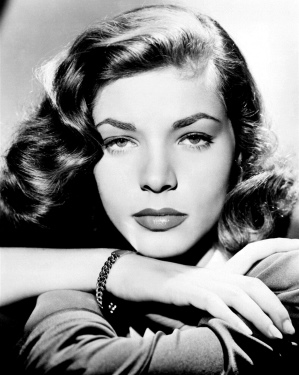 |
|
During her screen tests for
To Have and Have Not,
Bacall was so nervous that, to stop her chin
quivering, she pressed it against her chest, and
titled her face and eyes upward toward the
camera. This effect, gained the label "The
Look", and was another Bacall trademark
along with her throaty, sexy, voice. A month
before her 90th birthday, in 2014, Bacall died
in New York City after a stroke. |

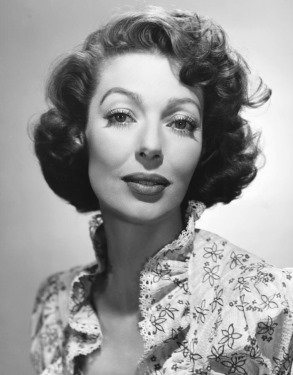 |
'The
Elegant' -
Loretta Young
Loretta
Young was born Gretchen Young in Salt Lake City,
Utah on January 6, 1913. She started as a child
actress, but makes our list for a few reasons; on
the strength of three Noir films, Orson Welles'
The Stranger
, William Dieterle's 1946
The Accused
and Tay Garnett's
Cause for Alarm,
secondly her remarkable beauty (often as a redhead)
as well as a dark side of her life that transpired
in 1935, during the shooting of
The Call of the Wild
where her co-star Clark Gable allegedly raped her
and she became pregnant. Young was 22 years old at
the time. This was kept from the press although many
knew and her mother left with her for Europe where
Loretta delivered a healthy baby girl on November
6th, 1935, whom she named Judith. Her daughter had
the tell-tale Gable ears that she later had
pinned-back and the facade continued with her
eventually being adopted by Miss Young 1 1/2 years
later. While this had widely been presumed to be an
affair, in 2015, Linda Lewis, Young's
daughter-in-law (and Christopher Lewis's wife)
stated publicly that, in 1998, Young told Lewis that
Gable had raped her; and that, though the two |
|
had flirted on set, there had been no affair
and no intimate contact save for that one
incident.
Young had not revealed the information
before to anyone. According to Lewis, Young
only stated it after having learned of the
concept of date rape; she had
previously always believed that it was a
woman's job to fend off men's amorous
advances, and had felt the fact that Gable
had been able to force himself on her thus
represented a moral failing on her part. The
event punctuates Young's successful career,
including her own television show, and a
fascinating Hollywood history. Loretta Young
died on August 12th 2000, Los Angeles, of
ovarian cancer at age 87. |

|
'The
Sly' -
Coleen Gray
Coleen Gray was born Doris Bernice Jensen in
1922, the daughter of a farmer. She passed
away on August 3, 2015 at 92 years of age.
Her legacy within the 'dark cinema' runs deep
and her absence from this page is the author's
oversight.
She
appeared in two iconic film noirs in 1947; in
Kiss of Death
she was ex-con Nick Bianco's (Victor Mature)
wife, Nettie, and as Tommy Udo's (Richard Widmark)
focus; and in
Nightmare Alley
as Stanton 'Stan' Carlisle's (Tyrone Power)
sideshow performer and mentalist wife, Molly -
street-smart but skirting the darkest side of
the business. |
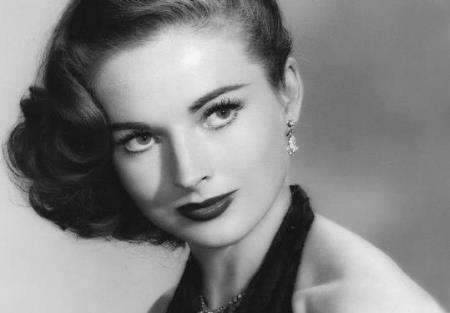 |
|
She
played a ward nurse in
The Sleeping City
(1950) forming a budding romance with undercover detective
Fred Rowen (Richard Conte.) She also appeared in
Phil Karlson's tense and violent
Kansas City Confidential
(1952) - resulting in a 2-year affair with
co-star John Payne. She was in Stanley Kubrick’s account
of an ambitious racetrack robbery;
The Killing,
portraying, Fay, an unsatisfied female desperate
for love. With much TV work on her resume fans
remember her for the later cult horror films
The Vampire
(1957),
The Leech Woman
(1960) and
The Phantom Planet (1961).
In 1979, staunch conservative Republican Coleen
Gray's third marriage was to widowed biblical
scholar Joseph Fritz Zeiser where they remained
highly active, till his death, with the 'Prison
Fellowship' - a non-profit organization founded
in 1976 by Charles Colson (a former prisoner
himself for his involvement in the Watergate
scandal), which assists the church in providing
ministry to prisoners and their families, as
well as their victims. Kind of an appropriate
later-life charity for a
Noir gal... |
|
![]()
![]()

![]()
![]()






























